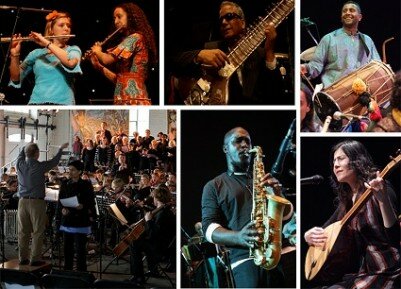02 March 2012
 Grand Union Orchestra. Photographs of sax player and flute player by Mark Channer. Photograph of orchestral conductor by Elizabeth Norden.
Grand Union Orchestra. Photographs of sax player and flute player by Mark Channer. Photograph of orchestral conductor by Elizabeth Norden.
About a year ago, taking part in an earlier Water City Festival event at Trinity Buoy Wharf, I stood just above the point where the River Lea meets the Thames, mesmerised by the waters meeting and mixing in the changing tide. What, I wondered, would the River sing if it could give voice to everything it had seen for the last thousand years?
There are many little-known places in East London that exude a sense of history, but none quite so atmospheric and expressive as Trinity Buoy Wharf.
An ancient lighthouse still keeps watch over the historic waterway, where a millenium of ships have sought safe passage to the docks, canals and river systems that have made East London the engine of Britain’s prosperity since well before the Industrial Revolution.
East London has also been historically a magnet for generations of migrants, refugees and those fleeing persecution, and that attraction continues in the present century. They all brought their skills and trades to the East End to enrich our lives, but they also brought their culture, and above all their music – all intermingling on a daily basis, like the waters at Trinity Buoy Wharf.
On March 4th, you can stand in the lee of the rusting lighthouse as I did a year ago. But now the river will be in full song – with African rhythms and chant, Bengali and Turkish song, music of the Portuguese navigators and Inuit eskimos, Indian rags and Russian melodies, jazz, bhangra and European classical music all rising on the evening tide…
For more details on What The River Sings, go to:
http://festival.london2012.com/events/9000961862
Post by Tony Haynes, Composer/ Director of Grand Union Orchestra.
Enter your email address below to join our mailing list: